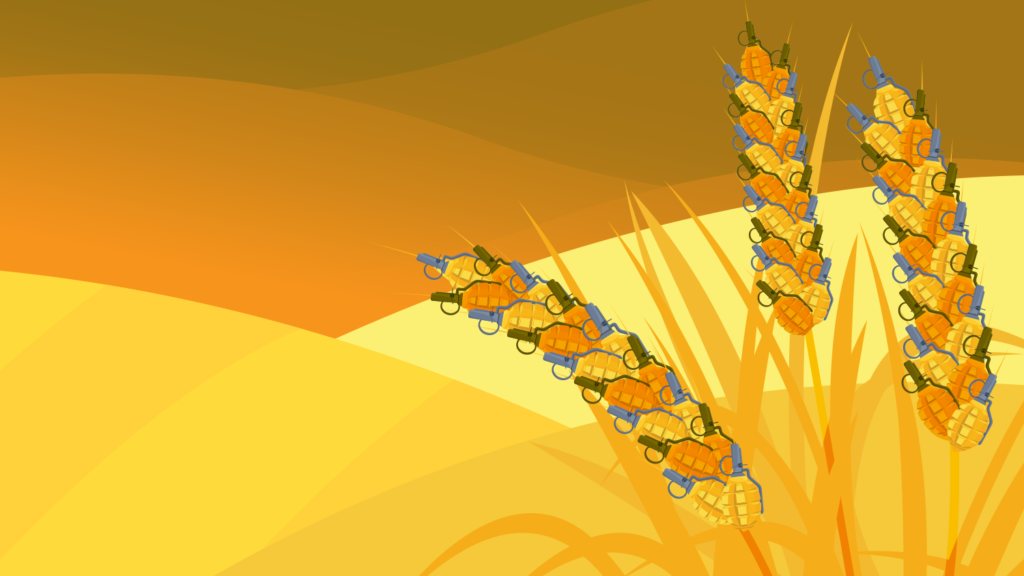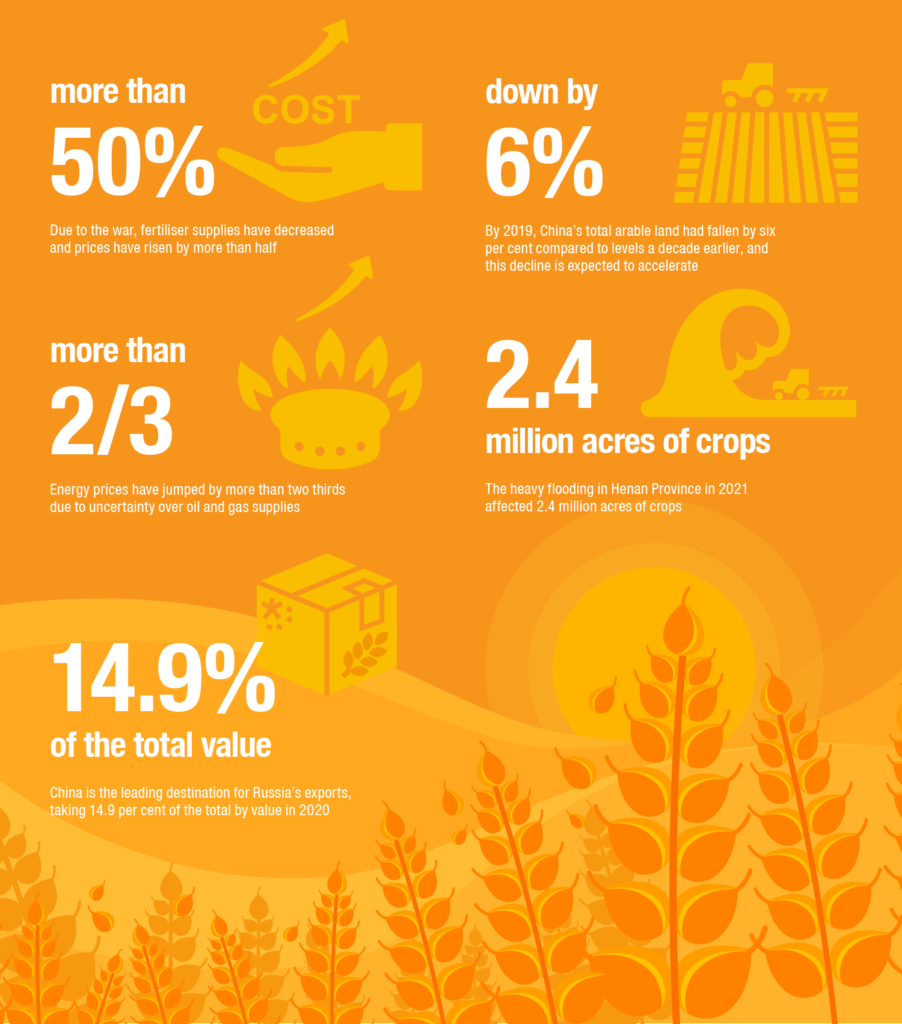
How does the war in Ukraine affect China’s food security?
While post-pandemic supply chain bottlenecks, rising energy prices and climate change have strained the food market for the past couple of years, Russia’s invasion of Ukraine in February 2022 has compounded the problem, deepening global food insecurity. With many manufacturers having fled Ukraine, further exacerbating disruptions to supply chains and trade partnerships, what is the impact on China’s food security and what are the implications for European businesses? Stephanie Sam, communications and business manager with the European Chamber, tells us more.
Where’s the grain?
The impact of Russia’s invasion of Ukraine has been felt in all corners of the globe; it has sent the prices of commodities and staple foods soaring, leading to fears of multiple famines.[1] Over a quarter of the world’s wheat exports originates from Russia and Ukraine, with Russia alone accounting for over 18 per cent.[2] Ukraine is a key exporter of many other grains as well, accounting for 16 per cent of all corn exports, and almost 10 per cent of all barley exports.[3] Before Russian and Ukraine signed a deal on 22nd July allowing the resumption of vital Ukrainian grain exports from Black Sea ports, Russian forces had blocked up to 23 per cent of expected wheat exports, even after Ukrainian shipments were rerouted via Romania and Poland.[4] While the rest of the world awaits to see if Russia will uphold its commitments, the situation highlights the egregious impact this war has had on agriculture and the market barriers that have gone up as a result.
Farming the world
But how does this affect China? The country is an overall net-importer of food and increasingly finds itself “running a food trade deficit”,[5] attributable to its rapid economic growth and urbanising population. In 2017, China imported United States dollars (USD) 105 billion in food in compared to exports of USD 59.6 billion.[6]As China shifts towards greater self-sufficiency, food security has been recognised as an “important foundation of national security” by President Xi.[7] For the first time ever, grain security was explicitly included in one of China’s Five-year Plans (FYPs), when it featured in the draft 14FYP (2021–2025),[8] highlighting the government’s ambitions to reach self-sufficiency in domestic food production.
China’s current food security strategy includes maximising domestic production and keeping “large stocks of staples such as corn, rice and wheat”.[9] To further strengthen its food security, China has also been aggressively purchasing overseas agricultural land for production, such as buying nearly one-tenth of Ukraine’s arable farmland in 2013.[10] In 2021, nearly a third of China’s corn imports and a quarter of its imported barley originated from Ukraine.[11]
Diminishing resources
Access to imported crops is only one piece of the puzzle though. Russia is also the biggest global exporter of commercial fertiliser, which is used to maximise agricultural yield output by 40–50 per cent. Due to the war, fertiliser supplies have decreased and prices risen by more than half, while energy prices have jumped by more than two thirds due to uncertainty over oil and gas supplies.[12] All of this increases costs for farmers and places further strain on the food production supply chain.
Pre-existing transnational factors such as climate change are also exacerbating food insecurity. While the war in Ukraine raises a question over expected exports, the loss of arable land due to climate change and environmental degradation also threatens China’s domestic food production. By 2019, China’s total arable land had fallen by six per cent compared to a decade earlier, and this decline is expected to accelerate.[13] Extreme weather, such as the heavy flooding in Henan Province in 2021 that affected 2.4 million acres of crops, is increasingly impacting China’s food insecurities.[14] Meanwhile, environmental issues such as widespread soil contamination have further damaged the land available for domestic production, increasing China’s dependence on imported food.

The geopolitical dilemma
In June 2022, United Nations Secretary-General António Guterres stated that “there can be no effective solution to the global food crisis without reintegrating Ukraine’s food production, as well as the food and fertiliser produced by Russia, into world markets.”[15] In disrupting billions of dollars of trade, the war in Ukraine has led to a “strategic predicament for China”.[16] While the European Union (EU) has staunchly advocated against Russian military aggression by implementing a series of financial and diplomatic sanctions, China has avoided any specific commitments to condemn or condone Moscow’s actions. This divergence was one of the main reasons the recent EU-China summit was described as a “dialogue of the deaf”.[17]
China is the leading destination for Russia’s exports, taking 14.9 per cent of the total by value in 2020.[18] In the past, China only approved wheat imports from seven defined areas in Russia over contamination concerns,[19] but since February 2022, Chinese customs have approved imports from all regions, indicating Russia and China’s increasing mutual dependence for exports amid EU sanctions. While Beijing sees very little to gain from “joining the international chorus condemning Moscow”,[20] China’s tolerance for Russia comes at a cost in terms of EU-China relations and may result in reduced EU dependence on Chinese supply lines in the future. In the quest to achieve food security, China will have to grapple with the geopolitical conundrum of the war in Ukraine.
NOTE
This article was written in early July, and reflects the circumstances at that time.
[1] Secretary-General Warns of Unprecedented Global Hunger Crisis, with 276 Million Facing Food Insecurity, Calling for Export Recovery, Debt Relief, United Nations, 24th June 2022, viewed 7th July 2022, <https://press.un.org/en/2022/sgsm21350.doc.htm>
[2] Duggal, Hanna and Haddad, Mohammed, Infographic: Russia, Ukraine and the global wheat supply, Al Jazeera, 17th February 2022, viewed 6th July 2022, <https://www.aljazeera.com/news/2022/2/17/infographic-russia-ukraine-and-the-global-wheat-supply-interactive>
[3] Åslund, Anders, Russia’s war on global food security, Atlantic Council, 1st June, viewed 6th July 2022, <https://www.atlanticcouncil.org/in-depth-research-reports/issue-brief/russias-war-on-global-food-security/>
[4] Borrell, Josep, Food insecurity: the time to act is now, European Union External Action, 7th April 2022, <https://www.eeas.europa.eu/eeas/food-insecurity-time-act-now_en>; Ukraine works to resume grain exports despite Russian strike on Odesa, Reuters, 24th July 2022, viewed 25th July 2022, <https://www.cnbc.com/2022/07/24/ukraine-works-to-resume-grain-exports-despite-russian-strike-on-odesa.html>
[5] How is China Feeding its Population of 1.4 Billion?, China Power 2022, <https://chinapower.csis.org/china-food-security/>
[6] Ibid
[7] Xi Focus Quotable Quotes: Xi Jinping on Food Security, Xinhua, 23rd July 2020, viewed 11th July 2022, <http://xinhuanet.com/english/2020-07/23/c_139235598.htm>
[8] Donnellon-May, Genevieve and Wang, Mark, China’s Evolving Food Security Strategy, The Diplomat, 25th November 2021, https://thediplomat.com/2021/11/chinas-evolving-food-security-strategy/
[9] MacDonald, Scott, China, Food Security and Geopolitics, The Diplomat, 30th September 2022, <https://thediplomat.com/2020/09/china-food-security-and-geopolitics/>
[10] Braw, Elisabeth, Why Does China Own So Much of Ukraine?, The Wall Street Journal, 29th June 2022, viewed 7th July 2022,<https://www.wsj.com/articles/why-does-china-own-so-much-ukraine-farming-land-exports-food-crisis-grow-wheat-production-sell-grain-territory-11656534819?mod=trending_now_opn_2>
[11] When China worries about food, the world pays, The Economist, 9th April 2022, <https://www.economist.com/china/2022/04/09/when-china-worries-about-food-the-world-pays>
[12] Secretary-General Warns of Unprecedented Global Hunger Crisis, with 276 Million Facing Food Insecurity, Calling for Export Recovery, Debt Relief, United Nations, 24th June 2022, viewed 7th July 2022, <https://press.un.org/en/2022/sgsm21350.doc.htm>
[13] China’s total arable land shrinks nearly 6% from 2009-2019 – survey, Reuters, 27th August 2021, <https://www.reuters.com/world/china/chinas-total-arable-land-shrinks-nearly-6-2009-2019-survey-2021-08-27/>
[14] Whiting, Kate, Food Security: This is how China plans to feed its 1.4 billion population, World Economic Forum, 11th March 2022, viewed 11th July 2022, <https://www.weforum.org/agenda/2022/03/china-seawater-rice-food-security/ >
[15] Secretary-General Warns of Unprecedented Global Hunger Crisis, with 276 Million Facing Food Insecurity, Calling for Export Recovery, Debt Relief, United Nations, 24th June 2022, viewed 7th July 2022, <https://press.un.org/en/2022/sgsm21350.doc.htm>
[16] Stein, Janice Gross, The Ukraine Dilema: Can the West Save Kyiv Without Starting a War With Russia?, Foreign Affairs, 9th March 2022, viewed 10th July 2022, <https://www.foreignaffairs.com/articles/russia-fsu/2022-03-09/ukraine-dilemma >
[17] Bermingham, Finbarr, EU-China summit was a ‘dialogue of the deaf’, says top Brussels diplomat, South China Morning Post, 6th April 2022, viewed 9th July 2022, <https://www.scmp.com/news/china/article/3173188/eu-china-summit-was-dialogue-deaf-says-top-brussels- diplomat>
[18] Broom, Douglas, What else does Russia export, beyond oil and gas?, World Economic Forum, 18th March 2022, <https://www.weforum.org/agenda/2022/03/russia-gas-oil-exports-sanctions/>
[19] Reidy, Susan, China OKs wheat imports from Russia, Sosland Publishing Company, 24th February 2022, <https://www.world-grain.com/articles/16536-china-oks-wheat-imports-from-russia>
[20] Stein, Janice Gross, The Ukraine Dilemma: Can the West Save Kyiv Without Starting a War With Russia?, Foreign Affairs, 9th March 2022, viewed 10th July 2022, <https://www.foreignaffairs.com/articles/russia-fsu/2022-03-09/ukraine-dilemma >


Recent Comments